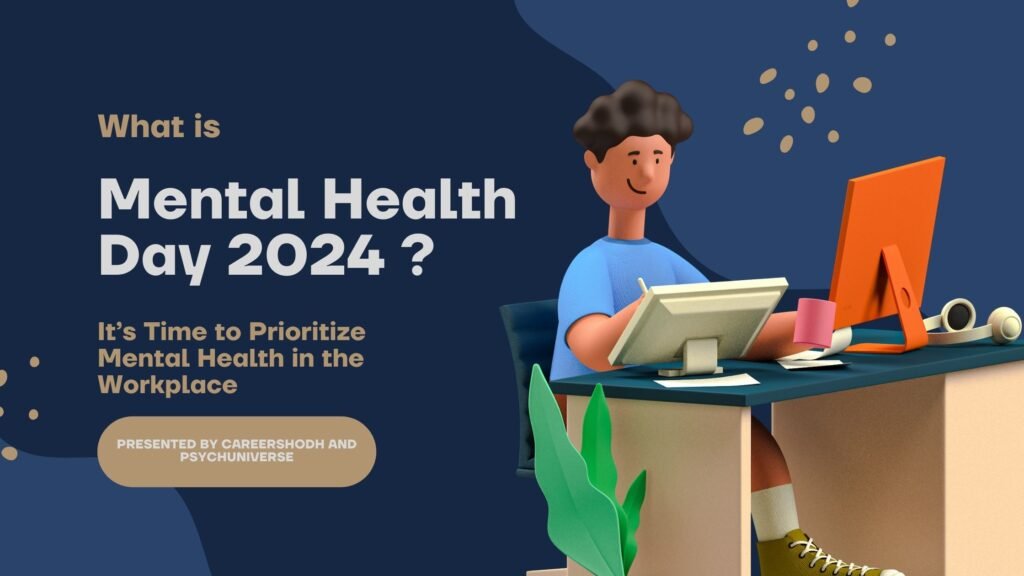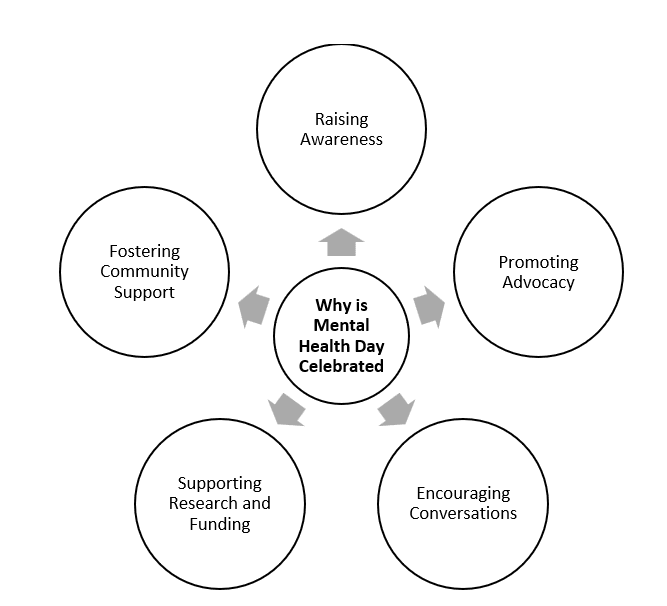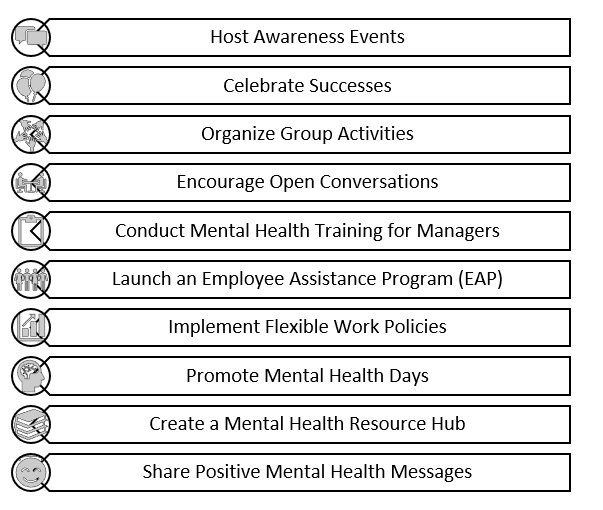Mental Health Day 2024
Mental health is an integral part of our overall well-being, yet it often takes a back seat in our fast-paced, performance-driven society. The need to address mental health issues, particularly in the workplace, has become increasingly pressing. Recognizing this need, the World Health Organization (WHO) has designated October 10 as World Mental Health Day. In 2024, the theme is “It’s Time to Prioritize Mental Health in the Workplace.”

Read More- What is Mental Health?
What is World Mental Health Day?
World Mental Health Day was established in 1992 by the World Federation for Mental Health, aiming to raise awareness about mental health issues and advocate for better mental health care globally. Each year, this day serves as a platform for individuals, communities, and organizations to engage in discussions, raise awareness, and take action toward improving mental health.
Mental Health Day is not just an event; it is a movement that encourages the understanding and support of mental health challenges. By sparking conversations about mental health, Mental Health Day seeks to empower individuals to seek help, provide support to those in need, and foster environments where mental health is prioritized and respected.
Why is World Mental Health Day Celebrated?
World Mental Health Day is celebrated for several essential reasons-
- Raising Awareness- Mental health issues affect millions worldwide, yet many remain unaware of their prevalence and impact. Raising awareness leads to understanding, reduces stigma, and encourages individuals to seek help.
- Promoting Advocacy- This day allows advocates, healthcare providers, and organizations to voice their concerns and recommendations regarding mental health policies, emphasizing the need for improved access to mental health services.
- Encouraging Conversations– Mental health discussions can be uncomfortable. However, World Mental Health Day creates a safe space for individuals to talk about their experiences without fear of judgment.
- Supporting Research and Funding– Many organizations use this day to highlight the importance of funding for mental health research, treatments, and initiatives. Increased funding can lead to better resources for those affected by mental health issues.
- Fostering Community Support- The day encourages individuals and communities to come together to support one another. Whether through local events or online campaigns, collective efforts can strengthen the message of mental health awareness.

Why is Mental Health Day Celebrated
The WMHD 2024 Theme- It’s Time to Prioritize Mental Health in the Workplace
For 2024, the theme of Mental Health Day, focuses on prioritizing mental health in the workplace. This theme is both timely and critical, as workplace environments significantly impact employees’ mental well-being. Here’s a deeper look at this theme-
- Workplace Culture- “It’s Time to Prioritize Mental Health in the Workplace” highlights the importance of creating a supportive work environment. Companies are increasingly recognizing that a positive workplace culture fosters employee satisfaction, productivity, and overall well-being.
- Breaking the Stigma– This theme encourages organizations to break the stigma associated with mental health in the workplace. It advocates for open discussions about mental health, allowing employees to feel safe discussing their challenges without fear of negative consequences.
- Access to Resources– The theme emphasizes the need for accessible mental health resources within organizations. This includes offering mental health days, access to counseling services, and training for managers to support employees effectively.
- Promoting Work-Life Balance- A focus on mental health in the workplace inherently promotes the need for work-life balance. Encouraging employees to take breaks, disconnect after hours, and prioritize their mental health can lead to happier, more productive employees.
- Long-term Benefits- Prioritizing mental health in the workplace not only benefits employees but also organizations as a whole. Research indicates that organizations that prioritize mental health experience reduced absenteeism, increased employee engagement, and improved performance .
A study conducted by the WHO (2022) found that depression and anxiety cost the global economy $1 trillion each year in lost productivity . By prioritizing mental health in the workplace, organizations can mitigate these costs and promote a healthier workforce. Furthermore, a survey by Mind Share Partners indicated that 76% of employees reported at least one symptom of a mental health condition in the past year , underscoring the need for workplace support.
The Importance of Prioritizing Mental Health in the Workplace
The importance of prioritizing mental health in the workplace cannot be overstated. Here are some reasons-
- Enhancing Employee Well-being- When organizations prioritize mental health, employees feel valued and supported. This enhances their overall well-being, leading to increased job satisfaction and retention rates. According to a survey by the American Psychological Association, employees who feel supported are more likely to remain in their positions and contribute positively to the company .
- Reducing Stigma- Creating a culture that prioritizes mental health helps to normalize discussions about mental well-being. This reduction in stigma encourages employees to seek help when needed, ultimately leading to a healthier work environment.
- Improving Productivity– Employees with better mental health are generally more productive. Studies show that organizations with supportive mental health policies see a significant increase in employee engagement and productivity levels. A report by Deloitte (2022) found that for every $1 invested in mental health initiatives, there is a return of $4 in improved health and productivity .
- Fostering a Positive Workplace Culture- Prioritizing mental health contributes to a positive workplace culture. This, in turn, fosters collaboration, creativity, and innovation among employees. A supportive environment allows individuals to thrive and contribute their best efforts to the organization .
- Enhancing Employee Engagement- Organizations that prioritize mental health often experience higher levels of employee engagement. Engaged employees are more likely to take ownership of their work and contribute to the company’s success. This engagement leads to better teamwork, communication, and overall performance .

Importance of Mental Health Day in the Workplace
How Can I Celebrate World Mental Health Day?
Celebrating World Mental Health Day can take many forms, especially in the workplace. Here are some creative and impactful ways to contribute to this important occasion-
- Host Awareness Events– Organize events such as seminars, workshops, or lunch-and-learn sessions focusing on mental health topics. Invite mental health professionals to share insights and strategies for managing stress and promoting well-being .
- Create a Mental Health Resource Hub– Establish a dedicated resource hub within the workplace that provides information on mental health services, support groups, and educational materials. Make sure employees know how to access these resources .
- Promote Mental Health Days- Encourage employees to take mental health days off when needed. Make it clear that prioritizing mental well-being is essential and supported by the organization. This can foster a culture where taking time off for mental health is normalized .
- Implement Flexible Work Policies– Introduce flexible work arrangements to help employees achieve a better work-life balance. This can include options for remote work, flexible hours, or compressed workweeks, allowing employees to manage their personal and professional lives more effectively .
- Launch an Employee Assistance Program (EAP)- Implement an Employee Assistance Program that offers confidential counseling services to employees. EAPs provide resources for employees dealing with personal or work-related challenges, ensuring they have access to support when needed .
- Conduct Mental Health Training for Managers- Provide training for managers to recognize the signs of mental health struggles and how to approach conversations with employees effectively. Training can empower managers to create a supportive atmosphere and respond appropriately to employees’ needs .
- Encourage Open Conversations- Foster an environment where open conversations about mental health are encouraged. Regular check-ins, team discussions, or anonymous surveys can help gauge employees’ well-being and provide opportunities for dialogue .
- Share Positive Mental Health Messages- Utilize internal communication platforms to share positive messages, quotes, and resources related to mental health. Highlighting mental health initiatives and stories of resilience can inspire employees to prioritize their well-being.
- Organize Group Activities- Plan team-building activities that promote mental well-being, such as yoga classes, mindfulness sessions, or nature walks. These activities encourage employees to connect and relieve stress together .
- Celebrate Successes- Acknowledge and celebrate the initiatives taken by the organization to support mental health. Recognizing achievements in promoting mental well-being can motivate employees and reinforce the importance of mental health .

How Can I Celebrate World Mental Health Day?
Mental Health Fun Facts
To make the topic of mental health more engaging, here are some fun facts that can help lighten the mood while still promoting awareness:
- Laughter is the Best Medicine– Research shows that laughter can reduce stress hormones and boost mood. A study published in the journal Therapeutic Advances in Psychopharmacology found that laughter increases the production of endorphins, the body’s natural feel-good chemicals, leading to improved mood and a sense of well-being. So, go ahead and watch that funny movie or share jokes with colleagues (Bennett & Lengacher, 2006) .
- Color Your Mood– Colors can affect your mood. For instance, blue is often associated with calmness, while yellow can evoke feelings of happiness. Research has shown that color can influence psychological and emotional responses. A study published in the journal Emotion found that individuals exposed to blue light reported feeling more relaxed, while yellow light increased feelings of happiness (Kaya & Epps, 2004). Consider decorating your workspace with colors that uplift you!
- Pet Power– Studies indicate that petting animals can reduce stress and anxiety levels. Research published in the Journal of Happiness Studies found that interactions with pets led to significant reductions in cortisol levels (the stress hormone) and increased oxytocin levels, which promote bonding and relaxation (Beck & Katcher, 2003). If you have a furry friend, consider bringing them into your life to enjoy some quality time and companionship.
- Dance it Out– Dancing can be an excellent way to boost your mood and release endorphins. A study published in the journal Arts in Psychotherapy found that dance can significantly improve mental health and emotional well-being by increasing feelings of joy and reducing feelings of anxiety and depression (Quiroga Murcia et al., 2010). Don’t hesitate to have a dance break during your workday!
- Nature Therapy– Spending time outdoors has been proven to reduce stress and improve mental health. Research published in the journal Environmental Science & Technology found that spending time in nature can lead to reductions in stress, anxiety, and depression, enhancing overall mood and well-being (Barton & Pretty, 2010). Plan a nature walk during lunch breaks to soak up the benefits of fresh air and greenery.
- Mindful Moments– Practicing mindfulness for just a few minutes a day can significantly impact your mental health. A meta-analysis published in Psychological Bulletin found that mindfulness practices can lead to moderate improvements in anxiety, depression, and stress (Khoury et al., 2015). Try focusing on your breath, taking a few deep breaths, or simply observing your surroundings.
Choosing to heal is the bravest step you can take. For mental health support, reach out to us on careershodh@gmail.com or find us at @careershodh
Conclusion
World Mental Health Day 2024 is a vital opportunity for organizations and individuals to prioritize mental health in the workplace. By embracing the theme “It’s Time to Prioritize Mental Health in the Workplace,” we can raise awareness, reduce stigma, and advocate for better mental health resources and policies.
As we approach October 10, let’s remember that everyone has a role to play in supporting mental well-being at work. Whether through conversations, advocacy, or simply taking time for self-care, every action counts. Let’s make mental health a priority and create healthier workplaces for all. Together, we can foster environments where everyone can thrive!
References
American Psychological Association. (2021). Workplace mental health. Retrieved from https://www.apa.org/news/press/releases/2021/09/workplace-mental-health
Barton, J., & Pretty, J. (2010). What is the best dose of nature and green exercise for improving mental health? Environmental Science & Technology, 44(10), 3962–3967. DOI: 10.1021/es903183r
Beck, A. M., & Katcher, A. H. (2003). Animal-assisted therapy in the treatment of depression. In A. H. Katcher & A. M. Beck (Eds.), New Perspectives on Our Lives with Companion Animals (pp. 127-142). Temple University Press.
Bennett, M. P., & Lengacher, C. A. (2006). Humor and Laughter in Health Care: A Review. Therapeutic Advances in Psychopharmacology, 6(3), 267–283. DOI: 10.1177/2045125322110964
Deloitte. (2022). Mental Health and Employers: The Investment Case. Retrieved from https://www2.deloitte.com/global/en/pages/about-deloitte/articles/mental-health-and-employers.html
Kaya, N., & Epps, H. H. (2004). Color preference and color-emotion associations in young children. Emotion, 4(1), 70-79. DOI: 10.1037/1528-3542.4.1.70
Khoury, B., Lecomte, T., Fortin, G., Massott, M., Therien, P., Bouchard, V., & Paquin, K. (2015). Mindfulness-based therapy: A comprehensive meta-analysis. Psychological Bulletin, 141(6), 1354-1369. DOI: 10.1037/bul0000001
Mind Share Partners. (2021). 2021 Mental Health at Work Report. Retrieved from https://mindsharepartners.org/2021-report
Quiroga Murcia, N., Kreutz, G., Clift, S., & Bongard, S. (2010). Shall we dance? An exploration of the perceived benefits of dancing on well-being. Arts in Psychotherapy, 37(2), 107-113. DOI: 10.1016/j.aip.2010.03.001
World Health Organization. (2022). Mental Health in the Workplace. Retrieved from https://www.who.int/news-room/fact-sheets/detail/mental-health-in-the-workplace
Subscribe to Careershodh
Get the latest updates and insights.
Join 15,005 other subscribers!
Niwlikar, B. A. (2024, October 5). Mental Health Day 2024- Find Out the Bold Theme for This Year. Careershodh. https://www.careershodh.com/mental-health-day/
